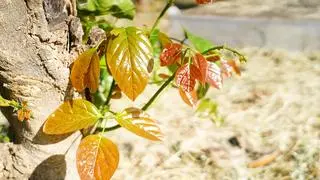It looks like a flat loofah, as big as an A5 paper, and it’s a sanitary napkin. Its creator, a freshly minted PhD from Anna University, Chennai, says it’s “India’s first and the world’s fastest biodegradable sanitary napkin”.
Dr Preethi Ramadoss says the napkin devised by her degrades completely in soil in just 15 days, if left undisturbed. What started in 2015 as her PhD project, under her guide Dr Arivuoli Dakshanamoorthy, culminated in the product by 2018 and received patent in 2020.
“The top and bottom layers of the napkin have to be hydrophobic to give a dry feel to the wearer and ensure it doesn’t leak. And the middle layer, in contrast, should be very absorbent. All these layers come from cellulose,” says Ramadoss, adding, “I was adamant that the layers must come from plant sources and was thinking of herbal extracts that have high levels of antibacterial properties. That’s when I zeroed in on turmeric, vetiver and neem. The super-absorbent middle layer is made of hydrophilic cellulose polymer mixed with natural fibres.”
How this Chennai researcher came up with ‘India’s first and fastest biodegradable sanitary napkin’
Elaborating on the absorbency of the layer, she says, “The layer can absorb fluids up to 1,700 times its weight. The natural fibres help spread the fluids evenly along the length of the napkin. Also, the super-absorbent middle layer contains deodorising lemon extracts.” The researcher adds that the napkin is quite breathable, hence preventing bacterial growth and infection.
On regular flow days, around three of these napkins would suffice, according to Ramadoss.
So, what exactly sets this product apart from the hundreds other sanitary napkin brands in the market? Ramadoss says that a lot of the feminine hygiene products that are marketed as ‘biodegradable’ contain polylactic acid (PLA) instead of plastic.
“It will not degrade completely. Even after a couple of years, if you dig up the spot where you buried it, you would still find bits of PLA,” she says, adding, “It is compostable, but the process of making PLA itself is quite polluting.”
Ramadoss is now seeking funding to sell the napkins commercially.
It currently costs Ramadoss ₹20 to produce each napkin since she uses research-grade products. “But the price will come down massively, on par with commercially available napkins, once I use industrial-grade raw materials,” she says. While napkins from major brands cost ₹10-12 each, those produced by the social entrepreneur ‘Padman’ Arunachalam Muruganantham cost ₹2.13.











Comments
Comments have to be in English, and in full sentences. They cannot be abusive or personal. Please abide by our community guidelines for posting your comments.
We have migrated to a new commenting platform. If you are already a registered user of TheHindu Businessline and logged in, you may continue to engage with our articles. If you do not have an account please register and login to post comments. Users can access their older comments by logging into their accounts on Vuukle.